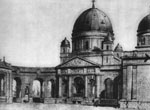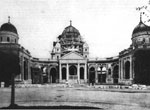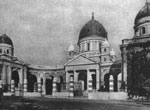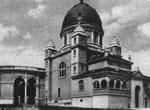About us

The Mirogoj Mortuary
After long debates, the construction of the Mortuary commenced in 1883. At the time, the custom was to have deceased family members lie in state at home, and the phrase “for the deceased to lie in state” had to be added to every sentence in which the mortuary was mentioned. Its construction was completed on 5 April 1886.
While the construction was still in progress, the Rules and Regulations for the Public Mortuary in Mirogoj were adopted in December 1885. Since the custom to have deceased family members lie in state at home was still deeply rooted in the community at the time, it was impossible to make the use of the mortuary for this purpose mandatory in the Rules and Regulations. The document stated that it was a possibility, but that it was not mandatory. The city authorities could in some cases order deceased persons to lie in state at the mortuary for reasons of public health and order. This applied in cases when the person died of a communicable disease or a skin condition, or when they lived in a cramped or overcrowded home where they could not await their burial. Deceased persons who were going to be subjected to an autopsy for any reason also had to be kept at the mortuary. For the first time, regulations were introduced governing the transportation of deceased persons, memorial services, transportation to the burial site, and the number of burials (which was restricted to one a day at the time).
The rules were an attempt to introduce more order, since the citizens were required to report all deaths to their parish office and the city authorities as a guarantee that these regulations would be enforced. The records were kept by the parish office, and the coroner’s report and the deceased person’s wishes regarding their burial were enclosed to the death registry.
Mr. Ivan Mischinger was the first person to lie in state at the mortuary on 15 January 1886.
TRAFFIC CONNECTIONS WITH MIROGOJ
People mostly walked to the Mirogoj Cemetery, and affluent citizens travelled there in their carriages. The horse-drawn tram that served as public transportation in Zagreb since 1811 could not get to the Mirogoj Cemetery because the Mirogoj Road (at the time called Gaj’s Hill) was too steep. When the electric tram was introduced in 1910, tram lines were immediately laid on Bakačeva ulica, via Kaptol and Nova ves, all the way to Mirogoj. The direct route to Mirogoj was cancelled in 1931. Passengers had to change trams at Gupčeva zvijezda, which they reached via a new tram line in the Medveščak Street. The tram service to Mirogoj operated without interruptions until a serious traffic accident occurred in 1954, after which there was no service to the Cemetery for almost 10 years. The tram line was fully restored and secured, however, apart from some trial runs, it was never again used for public transportation, and the power line carrier poles are the only surviving reminder of the former tram service.
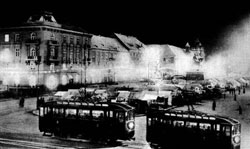
FOUNDATIONS
Obviously, a multitude of regulations had to be written to regulate the Mirogoj Cemetery and related affairs, making up a sort of “cemetery law”. There was the Cemetery’s Statute, the Rules and Regulations of the Mortuary, and special foundation regulations. All of these regulations occasionally had to be amended. The many regulations governing foundations are of particular interest.
There were, among other things, foundations for the poor, for schools, for monasteries, for priests, for hospitals, for the upkeep of hospital maids, and there was even a foundation for the maintenance of the clock on the tower of St. Mark’s Church. In 1885, there were 42 foundations in Zagreb managed by the city authorities, which had an impressive principal amounting to 126,381 forints. To put things into perspective, suffice it to say that Architect Bollé received 1,000 forints for all his work on St. Mark’s Church.
The funds of the Mirogoj Public Cemetery Foundation, Chapel Building Foundation, Grave Maintenance Foundation and Arcade Maintenance Foundation were spent on Mirogoj.
Interestingly, the principal of these foundations kept increasing, and the number of founders did not decrease considerably not even at the time of severe economic crisis. The assets of these foundations increased almost daily. They operated until World War II.
A document regulating the relations of the Cemetery and the users of its services was written in early 1889. The costs of certain types of services and, even more importantly, the manner of performance of these services were defined for the first time. The document was rather mixed up, but it did define the rates for the cemetery services. A principal had to be paid for each of the cemetery services, which in itself represented a form of foundation. The principals were paid to the city treasury for the Cemetery Foundation. The principal itself was never spent: they only spent the interest. If a surplus happened to be incurred, it was regularly spent on common cemetery maintenance costs, or, as the regulations put it, “general purposes of maintenance and decoration of the Mirogoj Park”.
Even though the principals were supposed to be maintained for as long as the Mirogoj Cemetery existed, the reality was different. As we know, the principals disappeared, the cemetery still exists, and grave maintenance has not been satisfactorily regulated to this day.
EXPANSION OF MIROGOJ
The last two decades of the 19th century could be dubbed a golden era of Mirogoj’s development. The Cemetery expanded continually and this process was unstoppable, but it was still slowed down considerably by numerous disputes. The city authorities strove to lower the prices of land purchased for the cemetery as much as possible, making them practically symbolical. The church authorities at the Zagreb Cathedral caused the most trouble for the city authorities. The Cathedral owned most of the land that was required for the expansion of Mirogoj, but preferred swapping its land to selling it to the city. Of course, some citizens were prepared to sell their land in exchange for any amount of money, even if it was a small one. Mirogoj thus expanded until it reached its present surface area.
CONSTRUCTION OF CENTRAL ARCADES AND CHAPEL
Architect Bollé’s unfulfilled wish was to build a central connecting point of the south and the north arcades (the portals and the chapel) after all other work on the arcades was completed as the crowning point of his work. The design of a large portal was made in 1914, but there were no funds for the realisation of such ideas during the war and in the post-war period. Still, Bollé kept hoping to see his ideas put to work. And they were, but he regrettably did not live to see it: the construction of the portal was completed on 1 November 1929, and the great master had passed away on 17 April 1926. Full 53 years passed from the written promise that the city authorities made to the Archbishop’s Office to the actual construction of the chapel. The reason for delays was always the same: lack of funding. Since the principal that the Foundation invested so much effort in collecting was lost in the war, Commissioner Heinzel made a decision that could be described as an advanced commercial move for the then circumstances, and raised the required funds by selling the future tombs in the church crypt. The works were supervised by Architect Rauscher, a close associate of Bollé’s.
CHANGES TO THE STATUTE AND REGULATIONS
Over time, the original Statute from 1876 became entirely unsuitable for the new circumstances. Campaigns to amend the Statute of the Mirogoj Cemetery were thus launched in 1913 and in 1937. Exhumations increased in frequency after it became apparent that the dimensions of fist class graves proscribed by the original Statute incurred high costs and were not aesthetically satisfactory. On top of all other flaws, the Cemetery faced a grave trading problem. It was possible to skirt the regulations and buy several graves in the same row, and then sell them on to others. The most important change proposed by the new Statute was that only cemetery personnel (”employees of the Foundation”) would be allowed to perform exhumations, open and seal tombs, and perform similar tasks in the future (finally!). Even though the new Statute was never formally adopted, everyone treated it as a rightfully adopted and valid regulation.
Other regulations were given legal status over the years, for instance, the Regulations on the Expanded Section of the Cemetery (1937), the Decision on Grave Development and Decoration (1954), the Statute of the Cemetery of the City of Zagreb (1950), and others.
While the construction was still in progress, the Rules and Regulations for the Public Mortuary in Mirogoj were adopted in December 1885. Since the custom to have deceased family members lie in state at home was still deeply rooted in the community at the time, it was impossible to make the use of the mortuary for this purpose mandatory in the Rules and Regulations. The document stated that it was a possibility, but that it was not mandatory. The city authorities could in some cases order deceased persons to lie in state at the mortuary for reasons of public health and order. This applied in cases when the person died of a communicable disease or a skin condition, or when they lived in a cramped or overcrowded home where they could not await their burial. Deceased persons who were going to be subjected to an autopsy for any reason also had to be kept at the mortuary. For the first time, regulations were introduced governing the transportation of deceased persons, memorial services, transportation to the burial site, and the number of burials (which was restricted to one a day at the time).
The rules were an attempt to introduce more order, since the citizens were required to report all deaths to their parish office and the city authorities as a guarantee that these regulations would be enforced. The records were kept by the parish office, and the coroner’s report and the deceased person’s wishes regarding their burial were enclosed to the death registry.
Mr. Ivan Mischinger was the first person to lie in state at the mortuary on 15 January 1886.
TRAFFIC CONNECTIONS WITH MIROGOJ
People mostly walked to the Mirogoj Cemetery, and affluent citizens travelled there in their carriages. The horse-drawn tram that served as public transportation in Zagreb since 1811 could not get to the Mirogoj Cemetery because the Mirogoj Road (at the time called Gaj’s Hill) was too steep. When the electric tram was introduced in 1910, tram lines were immediately laid on Bakačeva ulica, via Kaptol and Nova ves, all the way to Mirogoj. The direct route to Mirogoj was cancelled in 1931. Passengers had to change trams at Gupčeva zvijezda, which they reached via a new tram line in the Medveščak Street. The tram service to Mirogoj operated without interruptions until a serious traffic accident occurred in 1954, after which there was no service to the Cemetery for almost 10 years. The tram line was fully restored and secured, however, apart from some trial runs, it was never again used for public transportation, and the power line carrier poles are the only surviving reminder of the former tram service.

FOUNDATIONS
Obviously, a multitude of regulations had to be written to regulate the Mirogoj Cemetery and related affairs, making up a sort of “cemetery law”. There was the Cemetery’s Statute, the Rules and Regulations of the Mortuary, and special foundation regulations. All of these regulations occasionally had to be amended. The many regulations governing foundations are of particular interest.
There were, among other things, foundations for the poor, for schools, for monasteries, for priests, for hospitals, for the upkeep of hospital maids, and there was even a foundation for the maintenance of the clock on the tower of St. Mark’s Church. In 1885, there were 42 foundations in Zagreb managed by the city authorities, which had an impressive principal amounting to 126,381 forints. To put things into perspective, suffice it to say that Architect Bollé received 1,000 forints for all his work on St. Mark’s Church.
The funds of the Mirogoj Public Cemetery Foundation, Chapel Building Foundation, Grave Maintenance Foundation and Arcade Maintenance Foundation were spent on Mirogoj.
Interestingly, the principal of these foundations kept increasing, and the number of founders did not decrease considerably not even at the time of severe economic crisis. The assets of these foundations increased almost daily. They operated until World War II.
A document regulating the relations of the Cemetery and the users of its services was written in early 1889. The costs of certain types of services and, even more importantly, the manner of performance of these services were defined for the first time. The document was rather mixed up, but it did define the rates for the cemetery services. A principal had to be paid for each of the cemetery services, which in itself represented a form of foundation. The principals were paid to the city treasury for the Cemetery Foundation. The principal itself was never spent: they only spent the interest. If a surplus happened to be incurred, it was regularly spent on common cemetery maintenance costs, or, as the regulations put it, “general purposes of maintenance and decoration of the Mirogoj Park”.
Even though the principals were supposed to be maintained for as long as the Mirogoj Cemetery existed, the reality was different. As we know, the principals disappeared, the cemetery still exists, and grave maintenance has not been satisfactorily regulated to this day.
EXPANSION OF MIROGOJ
The last two decades of the 19th century could be dubbed a golden era of Mirogoj’s development. The Cemetery expanded continually and this process was unstoppable, but it was still slowed down considerably by numerous disputes. The city authorities strove to lower the prices of land purchased for the cemetery as much as possible, making them practically symbolical. The church authorities at the Zagreb Cathedral caused the most trouble for the city authorities. The Cathedral owned most of the land that was required for the expansion of Mirogoj, but preferred swapping its land to selling it to the city. Of course, some citizens were prepared to sell their land in exchange for any amount of money, even if it was a small one. Mirogoj thus expanded until it reached its present surface area.
CONSTRUCTION OF CENTRAL ARCADES AND CHAPEL
Architect Bollé’s unfulfilled wish was to build a central connecting point of the south and the north arcades (the portals and the chapel) after all other work on the arcades was completed as the crowning point of his work. The design of a large portal was made in 1914, but there were no funds for the realisation of such ideas during the war and in the post-war period. Still, Bollé kept hoping to see his ideas put to work. And they were, but he regrettably did not live to see it: the construction of the portal was completed on 1 November 1929, and the great master had passed away on 17 April 1926. Full 53 years passed from the written promise that the city authorities made to the Archbishop’s Office to the actual construction of the chapel. The reason for delays was always the same: lack of funding. Since the principal that the Foundation invested so much effort in collecting was lost in the war, Commissioner Heinzel made a decision that could be described as an advanced commercial move for the then circumstances, and raised the required funds by selling the future tombs in the church crypt. The works were supervised by Architect Rauscher, a close associate of Bollé’s.
CHANGES TO THE STATUTE AND REGULATIONS
Over time, the original Statute from 1876 became entirely unsuitable for the new circumstances. Campaigns to amend the Statute of the Mirogoj Cemetery were thus launched in 1913 and in 1937. Exhumations increased in frequency after it became apparent that the dimensions of fist class graves proscribed by the original Statute incurred high costs and were not aesthetically satisfactory. On top of all other flaws, the Cemetery faced a grave trading problem. It was possible to skirt the regulations and buy several graves in the same row, and then sell them on to others. The most important change proposed by the new Statute was that only cemetery personnel (”employees of the Foundation”) would be allowed to perform exhumations, open and seal tombs, and perform similar tasks in the future (finally!). Even though the new Statute was never formally adopted, everyone treated it as a rightfully adopted and valid regulation.
Other regulations were given legal status over the years, for instance, the Regulations on the Expanded Section of the Cemetery (1937), the Decision on Grave Development and Decoration (1954), the Statute of the Cemetery of the City of Zagreb (1950), and others.
